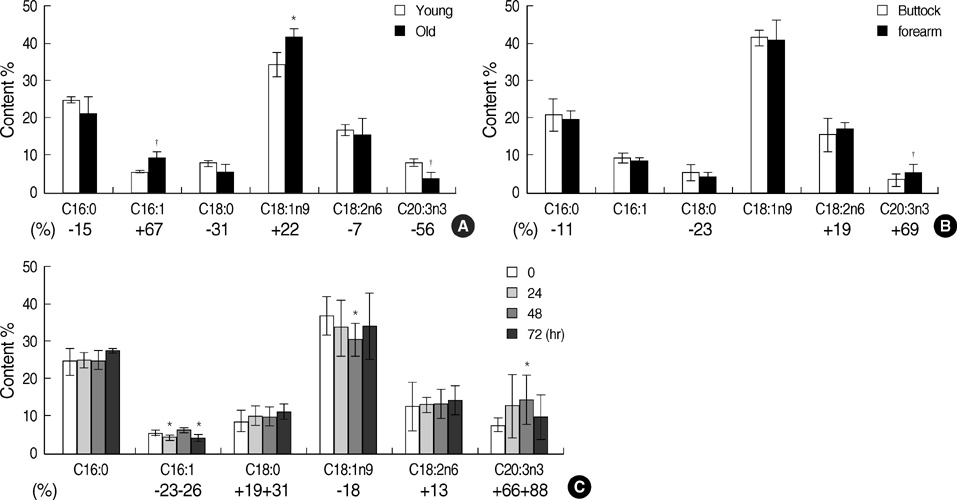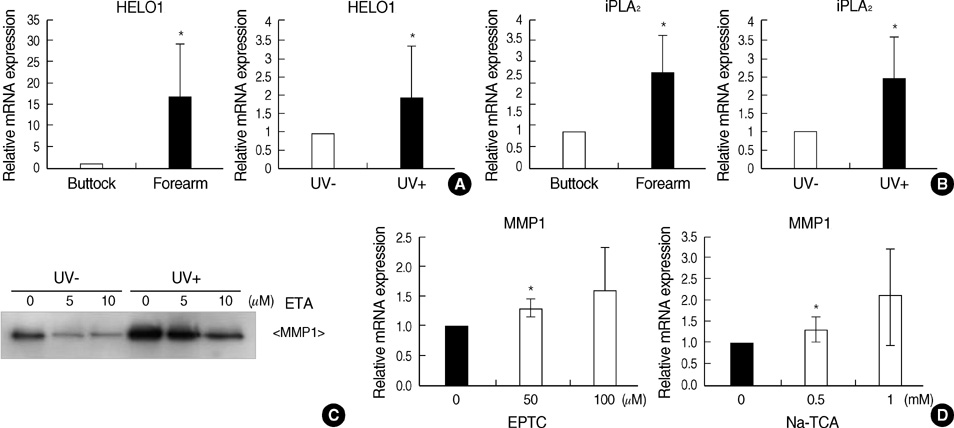J Korean Med Sci.
2010 Jun;25(6):980-983. 10.3346/jkms.2010.25.6.980.
Skin Aging and Photoaging Alter Fatty Acids Composition, Including 11,14,17-eicosatrienoic Acid, in the Epidermis of Human Skin
- Affiliations
-
- 1Department of Dermatology, Seoul National University College of Medicine, Laboratory of Cutaneous Aging Research, Clinical Research Institute, Seoul National University Hospital, Institute of Dermatological Science, Seoul National University, Seoul, Korea
- KMID: 2150885
- DOI: http://doi.org/10.3346/jkms.2010.25.6.980
Abstract
- We investigated the alterations of major fatty acid components in epidermis by natural aging and photoaging processes, and by acute ultraviolet (UV) irradiation in human skin. Interestingly, we found that 11,14,17-eicosatrienoic acid (ETA), which is one of the omega-3 polyunsaturated acids, was significantly increased in photoaged human epidermis in vivo and also in the acutely UV-irradiated human skin in vivo, while it was significantly decreased in intrinsically aged human epidermis. The increased ETA content in the epidermis of photoaged human skin and acute UV-irradiated human skin is associated with enhanced expression of human elongase 1 and calcium-independent phophodiesterase A2. We demonstrated that ETA inhibited matrix metalloproteinase (MMP)-1 expression after UV-irradiation, and that inhibition of ETA synthesis using EPTC and NA-TCA, which are elongase inhibitors, increased MMP-1 expression. Therefore, our results suggest that the UV increases the ETA levels, which may have a photoprotective effect in the human skin.
Keyword
Figure
Reference
-
1. Jenkins G. Molecular mechanisms of skin ageing. Mech Ageing Dev. 2002. 123:801–810.2. Fisher GJ, Kang S, Varani J, Bata-Csorgo Z, Wan Y, Datta S, Voorhees JJ. Mechanisms of photoaging and chronological skin aging. Arch Dermatol. 2002. 138:1462–1470.3. Trommer H, Wagner J, Graener H, Neubert RH. The examination of skin lipid model systems stressed by ultraviolet irradiation in the presence of transition metal ions. Eur J Pharm Biopharm. 2001. 51:207–214.4. Hansen HS, Jensen B. Essential function of linoleic acid esterified in acylglucosylceramide and acylceramide in maintaining the epidermal water permeability barrier. Evidence from feeding studies with oleate, linoleate, arachidonate, columbinate and alpha-linolenate. Biochim Biophys Acta. 1985. 834:357–363.5. Jump DB. Fatty acid regulation of gene transcription. Crit Rev Clin Lab Sci. 2004. 41:41–78.6. Siddiqui RA, Harvey KA, Zaloga GP. Modulation of enzymatic activities by n-3 polyunsaturated fatty acids to support cardiovascular health. J Nutr Biochem. 2008. 19:417–437.7. Jakobsson A, Westerberg R, Jacobsson A. Fatty acid elongases in mammals: their regulation and roles in metabolism. Prog Lipid Res. 2006. 45:237–249.8. Leonard AE, Bobik EG, Dorado J, Kroeger PE, Chuang LT, Thurmond JM, Parker-Barnes JM, Das T, Huang YS, Mukerji P. Cloning of a human cDNA encoding a novel enzyme involved in the elongation of long-chain polyunsaturated fatty acids. Biochem J. 2000. 350(Pt 3):765–770.9. Strokin M, Sergeeva M, Reiser G. Docosahexaenoic acid and arachidonic acid release in rat brain astrocytes is mediated by two separate isoforms of phospholipase A2 and is differently regulated by cyclic AMP and Ca2+. Br J Pharmacol. 2003. 139:1014–1022.10. Daviglus ML, Stamler J, Orencia AJ, Dyer AR, Liu K, Greenland P, Walsh MK, Morris D, Shekelle RB. Fish consumption and the 30-year risk of fatal myocardial infarction. N Engl J Med. 1997. 336:1046–1053.11. Kushi L, Giovannucci E. Dietary fat and cancer. Am J Med. 2002. 113:Suppl 9B. 63S–70S.12. Horrobin DF, Bennett CN. Depression and bipolar disorder: relationships to impaired fatty acid and phospholipid metabolism and to diabetes, cardiovascular disease, immunological abnormalities, cancer, ageing and osteoporosis. Possible candidate genes. Prostaglandins Leukot Essent Fatty Acids. 1999. 60:217–234.
- Full Text Links
- Actions
-
Cited
- CITED
-
- Close
- Share
- Similar articles
-
- Prevention of UV-Induced Skin Damages by 11,14,17-Eicosatrienoic Acid in Hairless Mice In Vivo
- Review of chemical peeling in photoaging skin
- Comparative Effects of Retin-A and Vitamin C on Photoaging Skin
- Review of topical vitamins in photoaging skin
- Lipids Analysis of Epidermis and Stratum corneum Using Circumcised Prepuce



